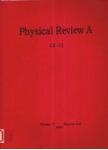版权所有:内蒙古大学图书馆 技术提供:维普资讯• 智图
内蒙古自治区呼和浩特市赛罕区大学西街235号 邮编: 010021

作者机构:Department of Nuclear and Atomic Physics Tata Institute of Fundamental Research Homi Bhabha Road Colaba Mumbai 400005 India College of Data Science Jiaxing University Jiaxing 314001 China Data Center for High Energy Density Physics Institute of Applied Physics and Computational Mathematics Beijing 100088 China
出 版 物:《Physical Review A》 (物理学评论A辑:原子、分子和光学物理学)
年 卷 期:2024年第109卷第3期
页 面:032819-032819页
核心收录:
学科分类:070207[理学-光学] 07[理学] 08[工学] 0803[工学-光学工程] 0702[理学-物理学]
基 金:Universitetet i Bergen, UiB Department of Atomic Energy, Government of India, DAE, (RTI 4002) Department of Atomic Energy, Government of India, DAE
主 题:Atomic & molecular collisions Scattering of atoms, molecules, clusters & ions Scattering theory
摘 要:We report on the combined experimental and theoretical studies of the single-electron capture collisions of Ar8+ projectiles with the H2 molecules at 1, 2, and 4 keV/u collision energies. The nondissociative recoil H2+ molecular ions are measured in coincidence with the charge-changing Ar7+ projectiles. The relative cross sections of the different state-selective capture channels are obtained from the experimentally measured Q-value spectra. The 1s electron transfers to the highly excited 4d+4f, 5s, 5p, 5d+5f+5g, 6s+6p, and 6d+6f+6g+6h states are resolved experimentally. The differential scattering angle distributions for the dominant 1s to 5s, 5p, and 5d+5f+5g transitions are compared with the two-center atomic orbital close-coupling methods. A collision energy-dependent dynamical coupling effect is also observed for the 1s→5p0 and 1s→5p±1 transitions. The dominant oscillatory structures in the scattering-angle distributions are attributed to Stueckelberg-type oscillations. In contrast, the less visible undulations in the smaller scattering angles imprint the signature of the quantum matter-wave scattering of the projectiles. The quantum nature of the oscillations in the angular distributions is further validated by classical calculations. Our study thus illustrates the highly excited quantum state-selective electron capture process and sheds light on the scattering-angle-range-dependent collision dynamics for highly charged ion-molecule collisions in the highly perturbative regime.